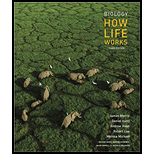
BIOLOGY:HOW LIFE WORKS (COMP.)-W/ACCESS
3rd Edition
ISBN: 9781319358075
Author: Morris
Publisher: Macmillan Higher Education
expand_more
expand_more
format_list_bulleted
Concept explainers
Question
Chapter 24.5, Problem 11SAQ
Summary Introduction
The size and shape of microorganisms are immediately revealed upon examination using a microscope. Among Archaea, several different morphologies are found. Archaeal cells vary in size ranging from 0.2 µm to >700 µm in diameter. In general, the size of rod-shaped cells ranges from 0.5 – 4 µm in width and <15 µm in length. Archaeal cells are prokaryotes and they do not possess a membrane-bound nucleus. Their genes are arranged in the form of a single circular chromosome.
Expert Solution & Answer
Want to see the full answer?
Check out a sample textbook solution
Students have asked these similar questions
What types of environments are inhabited by archaea? Why are methanogens important?
Why are prokaryotes so abundant and have such high diversity?
Why are archaea commonly referred to as extremophiles?
Chapter 24 Solutions
BIOLOGY:HOW LIFE WORKS (COMP.)-W/ACCESS
Knowledge Booster
Learn more about
Need a deep-dive on the concept behind this application? Look no further. Learn more about this topic, biology and related others by exploring similar questions and additional content below.Similar questions
- What are two ways that some prokaryotes are able to survive in extreme environments?arrow_forwardIf all prokaryotes were eliminated from the planeta) animals would thrive because there would be no disease.b) archaea would thrive because there would be no competition for nutrients.c) all animals would die.d) animals and archaea would thrive.arrow_forwardHow do archaea differ from bacteria?arrow_forward
- Why is there a debate as to whether archaea is classified as prokaryotic or eukaryoticarrow_forwardSome prokaryotes, especially archaea, are capable of living in extreme environments, such as deep-sea vents, where temperatures can reach 80°C (176°F). Few organisms can survive at this temperature. What adaptations might archaea possess that allow them to survive in such extreme heat?arrow_forwardWhich of the following organisms would be considered to be an autotroph? A) a yeast B) a mold C) a protozoan D) an algaarrow_forward
- The organisms with only one cell in their body are : A)blue green algae B)Mitochondria C)cell wallarrow_forwardWhy would archaea that grow in extreme environments be more intensively studied than those that do not?arrow_forwardMethanogenesis is a metabolic process found only among certain members of domain Archaea. A) O True B) O Falsearrow_forward
- Which of the following is true regarding the diversity of life ? a) Domain Archaea does not contain any disease-causing organisms. b) Bacteria can vary greatly in size and range up to 700 µm in length Microbial Eukarya may have first arisen two billion years ago, well before fungi, plants c) animal d) All of the above are true 7:33 /arrow_forwardIn which environments do bacteria live?arrow_forward What were the earliest forms of life on Earth? What was the energy source for the earliest form of life on earth? What are the earliest records of life on Earth? What is able to grow and thrive under conditions that would kill most other organisms (high/low pH, etc)? What are psychrophiles? Describe radioresistant prokaryotes and their habitat preferences. Who developed postulates to identify disease-causing organisms? What percent of bacteria and archaea cannot be cultured? Describe the viable-but-not-culturable state of prokaryotes. Describe planktonic prokaryotes. Why do biofilms form? What holds biofilms together? Structure of Prokaryotes Describe the nucleoid. Describe conjugation. What happens during binary fission? What are cell walls of prokaryotes primarily composed of? What structure of Archaea is different from other domains of life? What is the Bacteria division into two groups based on? Prokaryotic Metabolism Which macronutrient is…arrow_forward
arrow_back_ios
SEE MORE QUESTIONS
arrow_forward_ios
Recommended textbooks for you
 Biology (MindTap Course List)BiologyISBN:9781337392938Author:Eldra Solomon, Charles Martin, Diana W. Martin, Linda R. BergPublisher:Cengage Learning
Biology (MindTap Course List)BiologyISBN:9781337392938Author:Eldra Solomon, Charles Martin, Diana W. Martin, Linda R. BergPublisher:Cengage Learning

Biology (MindTap Course List)
Biology
ISBN:9781337392938
Author:Eldra Solomon, Charles Martin, Diana W. Martin, Linda R. Berg
Publisher:Cengage Learning
Chapter 5 Microbial Metabolism; Author: Heather Davis;https://www.youtube.com/watch?v=wH_HrsfDWZw;License: Standard Youtube License